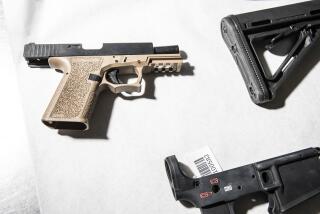The Big Gunfight at the Sacramento Corral
- Share via
There’s an old adage in sports--and politics: “If a fight starts, watch the crowd, because the crowd plays the decisive role.” How big and emotional the crowd is, where support or opposition shifts along the sidelines, help determine who wins.
Today the fight is over gun control and the politicians look to the crowd--the people who elected them to office and who keep them there--for the signal to fight or run.
Public opinion has remained generally supportive of gun control but the crowd usually pushing politicians has been the powerful National Rifle Assn. Time after time, it has taken tragedy to change the dynamic and force regulation onto the political agenda.
The assassinations of Martin Luther King Jr. and Robert F. Kennedy led to the passage of the federal Gun Control Act of 1968. That same year, liberal California Assemblyman Winfield A. Shoemaker (D-Santa Barbara) introduced gun-control legislation--over the objections of Assembly Democratic leaders who viewed it as a politically foolish move. Shoemaker was defeated for reelection by a conservative Republican challenger, reinforcing California legislators’ fear that they risked their jobs if they supported gun control.
In the wake of the attempted assassination of President Ronald Reagan, gun-control proponents qualified Proposition 15, which would have imposed the nation’s toughest state law on handgun control, for the November, 1982, ballot. They hoped it would motivate liberals to turn out for gun control and Democratic gubernatorial nominee Tom Bradley. But Proposition 15 lost by a nearly 2-1 margin. The crowd that turned out was an army of gun owners. Voting in rural counties ran about 10% higher than in the state’s urban areas.
Urban liberal hopes for a gun-control victory and a turnout that would aid Democratic candidates were dashed. Republican George Deukmejian, who opposed Proposition 15, defeated Bradley by a razor-thin margin, aided by support from the NRA. The perception was that Bradley’s candidacy was a victim of gun control and that had a chilling effect on politicians. The federal response to the Reagan shooting fared no better; the NRA engineered congressional rejection of a national seven-day waiting period for purchasing handguns--despite polls showing overwhelming public backing for such a law.
Now the California Legislature and Congress are again fighting the gun-control battle. And once again, “watch the crowd.”
The past few months have seen an unprecedented level of governmental activity on the issue. Bills are pending in Congress and at least 13 state legislatures--including California, Maryland, Virginia, Massachusetts, Connecticut and New Jersey--as well as several local governing bodies. What has happened?
For California, what happened is that Patrick Edward Purdy shot up a Stockton schoolyard with a semiautomatic rifle. It was a tragedy of stunning proportions--the kind that galvanizes public opinion and energizes the crowd. This time politicians saw that energy focused actively toward reform. And they seem to be responding.
Two major bills have center stage in California. Both AB 357, by Assemblyman Mike Roos (D-Los Angeles), and SB 292, by Sen. David Roberti (D-Los Angeles), generally prohibit the manufacture, sale, possession and transfer of semiautomatic military weapons, such as the AK-47 that Purdy used.
Current arguments in favor of gun control have embraced conservative concerns and popular ones. The debate is no longer over the issue of sportsmen’s rights. In the wake of skyrocketing violence in our nation’s cities--much of it drug-related--the gun lobby’s defense of semiautomatic weapons as “a great way to ease the tension of a hard week’s work” rings hollow. The issue is public safety.
In this era of fiscal constraint, a powerful argument is made that gun use should be controlled because it is costly to the taxpayers. The Assembly Public Safety Committee was told that as much as 85% of the costs of care for a shooting victim may be borne by taxpayers. The high-powered NRA, feared by politicians for its ability to mobilize voters and campaign contributions against legislators who stray from the pro-gun policy line, has stumbled recently; the gun lobby is losing its aura of invincibility.
In 1986, the lobby reportedly spent more than $2 million to defeat its congressional opponents, but failed to vanquish a single incumbent and lost several of its strongest backers. Despite the election of NRA lifetime member George Bush as President, it continued to lose clout in the 1988 elections. Every U.S. senator targeted by the NRA won reelection. Howard Metzenbaum (D-Ohio), singled out as NRA’s “greatest foe,” won by 600,000 votes. This year he introduced legislation to outlaw the importation and sale of new assault weapons.
The NRA also suffered its first defeat in a statewide referendum on gun control when it tried to repeal a Maryland handgun control law. Proponents of the law were outspent nearly 10-1 and won by 58% to 42%.
In California, the NRA was given credit for the victory of Assemblyman Willard H. Murray Jr. (D-Paramount) over Paul Zeltner, a Republican who had voted against the NRA to ban assault weapons. But here, too, the NRA’s increasingly heavy-handed tactics are losing credibility. Roberti has labeled the organization “the bully on the block.”
At the same time, the gun-control lobby shows greater sophistication, building broad-based coalitions and grass-roots support to offset the NRA’s vaunted electoral pressure. Pro-control forces have created mutually beneficial alliances with establishment politicians, including California Atty. Gen. John Van de Kamp, a likely Democratic candidate for governor in 1990. They have hired a veteran Sacramento lobbyist to guide them through the legislative maze and have begun a coordinated media campaign targeted at districts of key legislators.
And, although the partisanship which has helped to cripple policy still exists, legislative leaders like Roberti and Roos have made a refreshing commitment to use their clout on this issue. Said Roberti, the powerful Senate president pro tem, “In my own house, where my leadership means something . . . I will exert every bit of leadership I have.”
Deukmejian has indicated his willingness to sign brand-specific legislation banning the possession or sale of assault weapons. His stance should allow Republican legislators to feel comfortable enough to support some form of control.
Also significant is the shift in law-enforcement pressure. Until recently, the NRA and law enforcement fought together to advance the interests of sportsmen and endorse conservative “law and order” values. But in the face of escalating violent crime, law enforcement has split from the NRA’s hard-line approach. Nashville Police Chief Joe Casey observed, “On almost every recent gun-related issue supported by the police, the NRA has taken the opposing position--against bans on cop-killer bullets, in favor of a weakening of the 1968 Gun Control Act, against outlawing non-detectable plastic guns and now against legislation requiring a seven-day waiting period for gun purchases.”
Legislators are more willing to vote against the NRA when law enforcement stands with them. This is especially important for Democrats who represent conservative suburban and rural districts. They often find themselves caught between the demands of the legislative leadership and their own constituencies on the issue of gun control.
Law enforcement can reach Republicans, too. Assemblyman Charles W. Quackenbush (R-Saratoga), whose vote sent the Roos bill out of committee, explained, “If all of the police chiefs and D.A.s are on one side, there’s no way you can be out there with the NRA on the other.”
Media has also influenced the dynamic of the crowd. Hordes of television cameras recorded the Assembly meeting on gun control and every major Los Angeles television station sent a crew to cover committee hearings on the Roos and Roberti bills. Such media exposure focuses the attention of politicians and public alike.
Some form of assault weapons regulation appears headed for passage. What does all this mean? Not much, some would argue. Since meaningful regulation requires federal action, the politics of gun control in California is more symbolism than substance.
But, as it was on tax reform and insurance regulation, California will be watched as a trend-setting state. What happens here can give a movement momentum, media and money--or it can stop it cold.
In this case, California is the crowd. What we do here will help chart the course of life--and death--for Americans far beyond these violent times.
More to Read
Go beyond the scoreboard
Get the latest on L.A.'s teams in the daily Sports Report newsletter.
You may occasionally receive promotional content from the Los Angeles Times.










